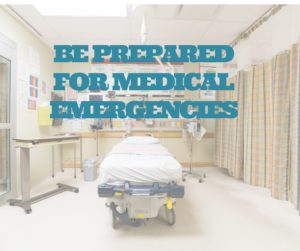What did you do last Friday night? We spent six hours in an urban emergency room waiting room. You can imagine the friends I made and saw while waiting for a bed to open up, especially after midnight on a weekend. Jealous? Many of us have been there and as I sat with my child, I was kicking myself. I should have had a better plan for when emergencies arise.
I’m a planner and my son is accident-prone. So, I thought I had a strategy in place. It busted.
My original intention was to go to an urgent care for lacerations (I had done the research and knew they can handle stitches and basic imagery). Turns out the one I visited closed at 8 pm and it was 8:20 pm. My second plan was to try one of these fancy new stand-alone emergency rooms. I figured comfort and less crowds would be lovely. Strike two: my insurance plan didn’t cover them even though my insurance plan says that anywhere is an option for emergency situations. Apparently, not all stand-alone ERs count as “anywhere” as they are “private”.
At this point, I had wasted 40 minutes and panicked. I went to the closest hospital ER.
Lesson learned.
Do you have a plan of attack for where you want to go when an emergency occurs?

- Research your insurance costs – Do your homework ahead of time and investigate your costs for service. For some, urgent care is a really expensive option. For others, it’s as cheap as a normal copay. The same goes for emergency rooms. Some folks have simple copays and others are going to pay a percentage of the entire bill. Learn how your plan works financially so that there are no unnecessary surprises.
- Research your insurance location options – You need to know if you are limited to certain places. I thought the sky was the limit during emergency options. Although I couldn’t go to all stand-alone locations, I have since learned that a few stand-alone emergency centers were indeed in network.
- Consider pediatric care – If possible, consider going to a children’s center. Not only is the bedside manner potentially preferable since the medical staff is used to dealing with children, but you are also limiting the population of people needing emergency attention. If adult patients are ruled out of the general crowd, there is hope that you might get in faster than a general hospital. In our scenario, we were competing with sick and injured adults AND children for the limited ER beds at a traditional hospital.
- Consider the suburbs – Again, this goes back to the idea of limiting the population. We chose a hospital in a very urban situation because the hospital was 10 minutes away and waited for 6 hours (until 3 am). While waiting, I wondered what our situation would have been like if we had been willing to drive 30 minutes to an area of town where there are less people. Friends have told me they have gone further out of town and had much quicker wait times. Of course, it’s always a gamble as to what the hospital is dealing with at that particular time. But, I’m inclined to take my risk and drive further if we can afford the driving minutes during that future urgent moment.
- Get comfy – When the emergency happened, I was dressed in a nice dress and heels on my way to dinner. I’m so glad I took the time to quickly change into comfy clothes, closed toe shoes (eww hospital germs), and grabbed an iPad. The hospital is cold and we waited long into the night. Again, time is not always a luxury, but if you have the time, stop and think about what you want to take while you wait. A movie on the iPad was also so nice to have.














What a great post! The new urgent car and stand alone ERs are popping up everywhere, and many people don’t realize that they can go to their pediatrician who knows their health history (and can save time and money!). I work at a pediatric clinic, and we’re trying to educate our patients on this. Will definitely share your article!